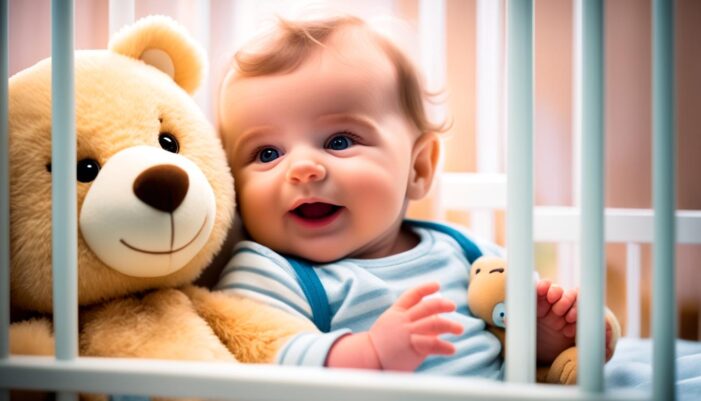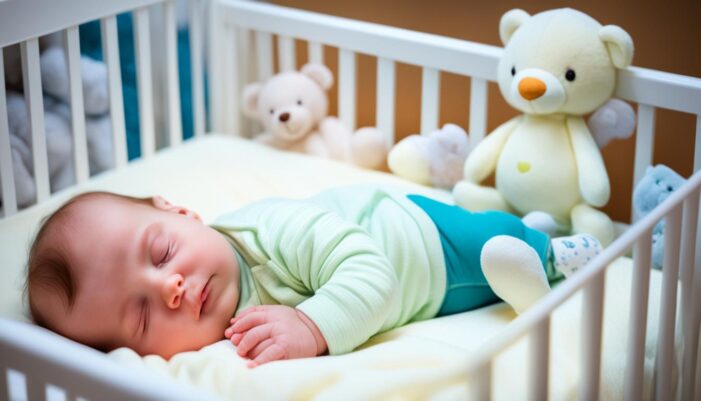As new and expecting parents, it’s natural to want to surround your little one with soft, cuddly toys. However, when it comes to sleep safety, it’s crucial to follow the recommended guidelines to ensure your baby’s wellbeing. The American Academy of Pediatrics advises keeping the sleep environment clear of loose bedding, blankets, stuffed animals, and other objects until a baby is at least 12 months old. This is because these items increase the risk of sudden infant death syndrome (SIDS) and death by suffocation or strangulation.
While the wait may seem long, there are excellent reasons behind this recommendation. Newborns and infants have a higher risk of SIDS, and any loose items in the crib can potentially cover their face or become trapped around their neck. Once your baby reaches their first birthday, you can safely introduce a soft, age-appropriate stuffed animal or “lovey” to keep them company during sleep.
Key Takeaways
- Newborns and infants should sleep in a clear, bare crib until 12 months old to reduce SIDS and suffocation risks.
- Stuffed animals and other soft objects should be avoided in the crib until your baby reaches their first birthday.
- Once your baby is 12 months old, you can safely introduce a soft, age-appropriate lovey or stuffed animal to provide comfort and security during sleep.
- Always consult your pediatrician if you have any concerns about introducing sleep toys or objects to your baby’s crib.
- Choosing the right size and type of stuffed animal is important for your baby’s safety and comfort.
The Importance of a Lovey and Its Benefits
A lovey is a special object, like a stuffed animal or blanket, that a baby or toddler forms an attachment to and uses for comfort. Loveys are also known as transitional objects, comfort objects, or security blankets. Providing a lovey can give a child a sense of security, especially during transitions, new experiences, and unfamiliar environments.
What is a Lovey?
A lovey is a cherished item that a child becomes emotionally attached to, finding solace and security in its presence. It can be a soft toy, a blanket, or any other object that the child grows fond of and uses to soothe themselves. Loveys are a natural part of a child’s development, helping them navigate the world around them with a sense of reassurance.
What are the Benefits of a Lovey?
A lovey can provide numerous benefits for a child’s development and well-being. Hugging a lovey releases oxytocin, a calming hormone that helps reduce stress and promote feelings of comfort. Incorporating a lovey into a bedtime routine can also help cue a child’s brain that it’s time for sleep, making the transition to slumber smoother.
Loveys can also help combat separation anxiety and provide reassurance during times of stress or discomfort, such as teething or illness. The American Academy of Pediatrics supports the use of a lovey as a tool for emotional support, stating that they are not a sign of weakness or insecurity.
In summary, a lovey can be a valuable asset in a child’s life, offering emotional security, comfort, and support during their early years of development. By embracing the benefits of a lovey, parents can help their little ones navigate the challenges of growing up with a trusted companion by their side.
When to Start Buying Baby Stuff
Preparing for a new baby can be an exciting and overwhelming experience. When it comes to buying baby essentials, it’s important to strike the right balance between being prepared and avoiding impulse purchases. One key item to consider introducing early on is a lovey or comfort object.
How to Introduce a Lovey
While a lovey or comfort object should only be used in the crib for sleep after a child’s first birthday, it can be introduced and incorporated into a child’s life at any age. Suggestions for introducing a lovey include:
- Rubbing it on the child’s cheeks during feeding
- Snuggling with it during book reading
- Taking it on walks in the stroller
- Offering it when the child is upset
When a child is 12 months or older, the lovey can be included in the bedtime routine, with parents kissing it goodnight and encouraging the child to do the same. It’s important to be patient, as some children may not immediately take to a lovey, and to have at least two of the same lovey to rotate and avoid stress if one is lost or left behind.

By introducing a lovey early on, parents can help their child develop a comforting attachment that can provide security and soothe them during times of stress or separation. With a little patience and consistency, a lovey can become a cherished companion for years to come.
Conclusion
In conclusion, the article has provided guidance on safely incorporating stuffed animals and loveys into a baby’s sleep routine. It is essential to wait until a baby is at least 12 months old before allowing them to sleep with a stuffed animal or comfort object, as this reduces the risk of SIDS and suffocation. Loveys can offer numerous benefits, such as providing emotional support, cuing the brain for sleep, and helping with separation anxiety.
By following safe sleep guidelines and introducing a lovey thoughtfully, parents can help their child develop a positive attachment and experience the comfort and security that a beloved object can provide. The article has emphasized the importance of prioritizing a baby’s safety while also recognizing the value of a lovey in supporting their emotional and developmental needs.
Overall, this comprehensive guide has equipped parents with the knowledge and strategies to navigate the use of stuffed animals and loveys in their child’s sleep routine, ensuring a restful and secure environment for their little one to thrive.
FAQ
When is it safe for a baby to sleep with a stuffed animal?
It’s important to wait until a baby is at least 12 months old before allowing them to sleep with a stuffed animal or comfort object. Loose bedding, blankets, and toys can increase the risk of sudden infant death syndrome (SIDS) and death by suffocation or strangulation in babies under 12 months.
What are the benefits of a lovey or security object for a baby?
A lovey, also known as a comfort object or security blanket, can provide numerous benefits for a child’s development and well-being. Hugging a lovey releases oxytocin, a calming hormone, and incorporating it into a bedtime routine can help cue a child’s brain that it’s time for sleep. Loveys can also help combat separation anxiety and provide reassurance during times of stress or discomfort.
How should a lovey be introduced to a baby?
While a lovey should only be used in the crib for sleep after a child’s first birthday, it can be introduced and incorporated into a child’s life at any age. Suggestions for introducing a lovey include rubbing it on the child’s cheeks during feeding, snuggling with it during book reading, and offering it when the child is upset. It’s important to be patient, as some children may not immediately take to a lovey, and to have at least two of the same lovey to rotate and avoid stress if one is lost or left behind.
What should parents keep in mind when choosing a stuffed animal or lovey for their baby?
When selecting a stuffed animal or lovey for a baby, it’s important to choose a soft, age-appropriate size that does not pose a suffocation or strangulation risk. It’s also a good idea to have multiple duplicates of the same lovey to rotate and avoid stress if one is lost or left behind.
When should parents consult a pediatrician about introducing a comfort object?
Parents should consult a pediatrician if they have any concerns or questions about introducing a comfort object, such as a stuffed animal or lovey, to their baby. The pediatrician can provide guidance on safe sleep practices and ensure that the child’s needs are being met.
Source Links
- https://takingcarababies.com/loveys?srsltid=AfmBOoq0Grmms4C3Cy5X2HtabDg-Q2Fybd2LQ-YwPMUOgspr1KvScjth
- https://www.babycenter.com/baby/sleep/when-can-my-baby-sleep-with-a-stuffed-animal-or-doll_1368443
- https://sleepoutcurtains.com/blogs/home/when-can-baby-sleep-with-stuffed-animal?srsltid=AfmBOopVuLz7aAwLQ9-45FltK5gbgZe_rU6dstfUZ_NUKdfNtRwkxg_3

